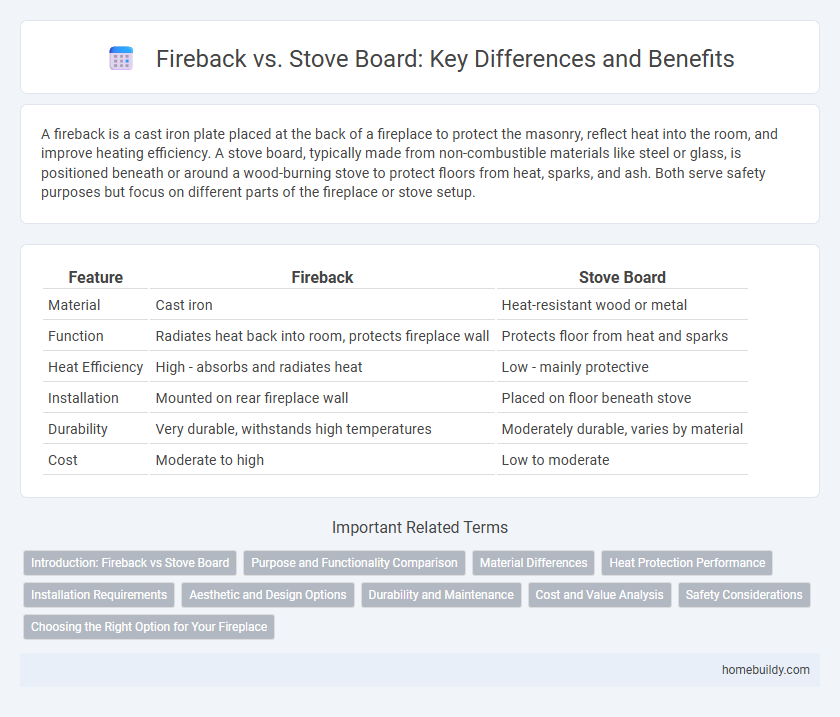A fireback is a cast iron plate placed at the back of a fireplace to protect the masonry, reflect heat into the room, and improve heating efficiency. A stove board, typically made from non-combustible materials like steel or glass, is positioned beneath or around a wood-burning stove to protect floors from heat, sparks, and ash. Both serve safety purposes but focus on different parts of the fireplace or stove setup.
Table of Comparison
| Feature | Fireback | Stove Board |
|---|---|---|
| Material | Cast iron | Heat-resistant wood or metal |
| Function | Radiates heat back into room, protects fireplace wall | Protects floor from heat and sparks |
| Heat Efficiency | High - absorbs and radiates heat | Low - mainly protective |
| Installation | Mounted on rear fireplace wall | Placed on floor beneath stove |
| Durability | Very durable, withstands high temperatures | Moderately durable, varies by material |
| Cost | Moderate to high | Low to moderate |
Introduction: Fireback vs Stove Board
Firebacks are typically made of cast iron and serve as protective and heat-retaining barriers positioned at the back of a fireplace, enhancing warmth distribution. Stove boards are flat, heat-resistant panels installed beneath wood-burning stoves to protect flooring from heat and sparks. Both firebacks and stove boards improve safety and efficiency in heating appliances but fulfill distinct roles based on their placement and function.
Purpose and Functionality Comparison
Firebacks serve as heat-resistant barriers installed behind fireplaces to protect walls and reflect heat into the room, enhancing warmth and safety. Stove boards, typically placed beneath wood stoves, shield floors from heat and embers, preventing damage and fire hazards. While firebacks optimize heat radiation and wall protection, stove boards primarily ensure floor safety and stability for heating appliances.
Material Differences
Firebacks are typically made from cast iron, which provides excellent heat retention and durability, making them ideal for reflecting heat back into the room. Stove boards, on the other hand, are usually constructed from steel or ceramic materials designed to protect flooring from heat and sparks rather than reflect heat. The cast iron in firebacks contributes to slower, steadier warming, whereas stove boards prioritize safety and surface protection with materials that tolerate high temperatures without damage.
Heat Protection Performance
Firebacks provide superior heat protection performance compared to stove boards due to their robust cast iron construction, which efficiently absorbs and radiates heat while safeguarding the wall from high temperatures. Stove boards, typically made of heat-resistant materials like vermiculite or stone, offer adequate protection but lack the thermal mass and heat distribution capabilities of firebacks. The enhanced heat retention and durability of firebacks make them a more effective option for protecting surrounding surfaces from intense heat exposure.
Installation Requirements
Firebacks require minimal installation, simply placed at the back of the fireplace to protect the wall and enhance heat reflection, with no need for adhesives or mounting hardware. Stove boards demand a flat, heat-resistant surface and often require securing to the floor or wall for stability and safety during stove operation. Both installation methods prioritize fire safety but differ in complexity, with firebacks offering a straightforward setup compared to the more involved process of stove board installation.
Aesthetic and Design Options
Firebacks offer intricate, cast iron designs that add a timeless, decorative element to fireplaces, showcasing detailed patterns and historical motifs. Stove boards, made from materials like steel or ceramic, provide a more modern, minimalistic look with smooth surfaces and customizable colors, blending seamlessly with various interior styles. Choosing between a fireback and stove board depends on whether you prefer classic artistry or contemporary simplicity for your hearth's aesthetic.
Durability and Maintenance
Firebacks are typically made from cast iron, offering superior durability and resistance to high temperatures compared to stove boards, which are often constructed from thinner steel or composite materials. Cast iron Firebacks require minimal maintenance, needing occasional cleaning and seasoning to prevent rust, whereas stove boards may degrade faster and necessitate more frequent replacement or repair. Their robustness ensures Firebacks provide long-lasting protection for fireplace walls, enhancing both safety and heat efficiency over time.
Cost and Value Analysis
Firebacks typically offer greater long-term value due to their durable cast iron construction, which provides efficient heat reflection and protection for fireplace interiors. Stove boards generally cost less upfront but may lack the longevity and heat retention properties that firebacks possess, potentially leading to more frequent replacements. Evaluating overall cost-effectiveness, firebacks represent a better investment for enhancing both fireplace efficiency and durability.
Safety Considerations
Firebacks provide essential protection by shielding the rear wall of a fireplace from intense heat and preventing damage, often made of durable cast iron or steel for enhanced safety. Stove boards, typically placed beneath wood stoves, protect flooring from sparks and heat, usually featuring non-combustible materials like stone or metal to reduce fire risk. Choosing between firebacks and stove boards depends on the specific safety needs of the installation, as firebacks mitigate wall damage while stove boards safeguard floors against heat and embers.
Choosing the Right Option for Your Fireplace
Firebacks are typically made of cast iron and provide excellent heat reflection, improving the warmth and efficiency of a fireplace, while stove boards are often constructed from fire-resistant materials like stone or concrete and serve primarily to protect surrounding floors and walls from heat damage. When choosing between a fireback and a stove board, consider whether your priority is enhancing heat output and distribution or safeguarding nearby areas from sparks and embers. Firebacks are ideal for maximizing heat retention inside the fireplace, whereas stove boards offer crucial protection for flooring, especially in installations where the hearth dimensions or materials require additional safety measures.
Fireback vs Stove Board Infographic

 homebuildy.com
homebuildy.com